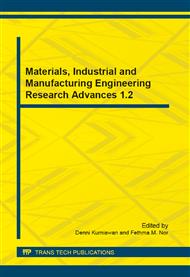[1]
K. Fujihara, M. Kotaki, and S. Ramakrishna, Guided bone regeneration membrane made of polycaprolactone/calcium carbonate composite nano-fibers., Biomaterials, vol. 26, no. 19, pp.4139-47, Jul. (2005).
DOI: 10.1016/j.biomaterials.2004.09.014
Google Scholar
[2]
M. C. Bottino, V. Thomas, and G. M. Janowski, A novel spatially designed and functionally graded electrospun membrane for periodontal regeneration., Acta biomaterialia, vol. 7, no. 1, pp.216-24, Jan. (2011).
DOI: 10.1016/j.actbio.2010.08.019
Google Scholar
[3]
G. R. Owen, J. K. Jackson, B. Chehroudi, D. M. Brunette, and H. M. Burt, An in vitro study of plasticized poly(lactic-co-glycolic acid) films as possible guided tissue regeneration membranes: material properties and drug release kinetics., Journal of biomedical materials research. Part A, vol. 95, no. 3, pp.857-69, Dec. (2010).
DOI: 10.1002/jbm.a.32865
Google Scholar
[4]
B. Kouidhi, T. Zmantar, H. Hentati, and A. Bakhrouf, Cell surface hydrophobicity, biofilm formation, adhesives properties and molecular detection of adhesins genes in Staphylococcus aureus associated to dental caries., Microbial pathogenesis, vol. 49, no. 1-2, pp.14-22, (2010).
DOI: 10.1016/j.micpath.2010.03.007
Google Scholar
[5]
O. -derived Cathelicidins, R. C. Anderson, R. E. W. Hancock, and P. -lam Yu, Antimicrobial Activity and Bacterial-Membrane Interaction of Antimicrobial Activity and Bacterial-Membrane Interaction of Ovine-Derived Cathelicidins, vol. 48, no. 2, (2004).
DOI: 10.1128/aac.48.2.673-676.2004
Google Scholar
[6]
F. Liu, B. Qin, L. He, and R. Song, Novel starch/chitosan blending membrane: Antibacterial, permeable and mechanical properties, Carbohydrate Polymers, vol. 78, no. 1, pp.146-150, Aug. (2009).
DOI: 10.1016/j.carbpol.2009.03.021
Google Scholar
[7]
E. E. Machtei, M. I. Cho, R. Dunford, J. Norderyd, J. J. Zambon, and R. J. Genco, Clinical, microbiological, and histological factors which influence the success of regenerative periodontal therapy., Journal of periodontology, vol. 65, no. 2. pp.154-61, Feb-(1994).
DOI: 10.1902/jop.1994.65.2.154
Google Scholar
[8]
M. C. Bottino et al., Recent advances in the development of GTR/GBR membranes for periodontal regeneration-A materials perspective., Dental materials : official publication of the Academy of Dental Materials, vol. 28, no. 7, pp.703-21, Jul. (2012).
DOI: 10.1016/j.dental.2012.04.022
Google Scholar
[9]
A. H. K. Chou, R. Z. LeGeros, Z. Chen, and Y. Li, Antibacterial effect of zinc phosphate mineralized guided bone regeneration membranes., Implant dentistry, vol. 16, no. 1, pp.89-100, Mar. (2007).
DOI: 10.1097/id.0b013e318031224a
Google Scholar
[10]
D. Yang et al., The antimicrobial activity of liposomal lauric acids against Propionibacterium acnes., Biomaterials, vol. 30, no. 30, pp.6035-40, Oct. (2009).
DOI: 10.1016/j.biomaterials.2009.07.033
Google Scholar
[11]
G. Bergsson, J. Arnfinnsson, and H. Arnfinnsson, In Vitro Killing of Candida albicans by Fatty Acids and Monoglycerides In Vitro Killing of Candida albicans by Fatty Acids and Monoglycerides, vol. 45, no. 11, (2001).
DOI: 10.1128/aac.45.11.3209-3212.2001
Google Scholar
[12]
M. Reise et al., Release of metronidazole from electrospun poly(L-lactide-co-D/L-lactide) fibers for local periodontitis treatment., Dental materials : official publication of the Academy of Dental Materials, vol. 28, no. 2, pp.179-88, Feb. (2012).
DOI: 10.1016/j.dental.2011.12.006
Google Scholar
[13]
P. Appendini and J. H. Hotchkiss, Review of antimicrobial food packaging, Innovative Food Science & Emerging Technologies, vol. 3, no. 2. pp.113-126, Jun-(2002).
DOI: 10.1016/s1466-8564(02)00012-7
Google Scholar
[14]
T. Kitahara et al., In vitro activity of lauric acid or myristylamine in combination with six antimicrobial agents against methicillin-resistant Staphylococcus aureus (MRSA)., International journal of antimicrobial agents, vol. 27, no. 1, pp.51-7, Jan. (2006).
DOI: 10.1016/j.ijantimicag.2005.08.020
Google Scholar
[15]
A. P. Desbois and V. J. Smith, Antibacterial free fatty acids: activities, mechanisms of action and biotechnological potential., Applied microbiology and biotechnology, vol. 85, no. 6, pp.1629-42, Feb. (2010).
DOI: 10.1007/s00253-009-2355-3
Google Scholar


